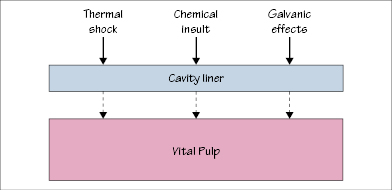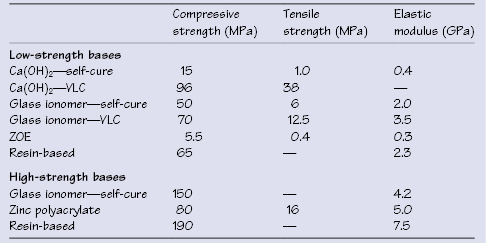26
Cavity varnishes, liners, and bases
Figure 26.1 Cavity liner reducing the adverse effects of heat, chemicals, and galvanic effects on the dental pulp.

Box 26.1 Requirements of bases and liners
Biological compatibility
Low thermal conductivity
Low solubility
High strength
Chemical protection
Box 26.2 Factors affecting integrity and efficacy of liners and base
Degree of set at restoration placement
Strength and thickness of liner
Cavity design
Force exerted during restoration placement
Support by surrounding hard tissue
Operative technique
Box 26.3 Requirements of high-strength bases
Provide thermal protection
Support the restoration
Higher strength than liners
Higher viscosity than liners
Bond to tooth substance
Table 26.1 Average mechanical properties of low- and high-strength bases

Cavity varnishes can provide barriers at the tooth–restoration interface against migration of irritants from restorations and/or oral fluids into the dentin. Cavity liners function both as barriers and in exerting therapeutic effects.
26.1 Cavity varnishes
A cavity varnish provides a barrier against fluid penetration into the underlying dentin. When applied to dentin, a varnish may reduce postoperative sensitivity and limit migration of corrosion products into dentin, thereby reducing tooth discoloration.
Stay updated, free dental videos. Join our Telegram channel

VIDEdental - Online dental courses


